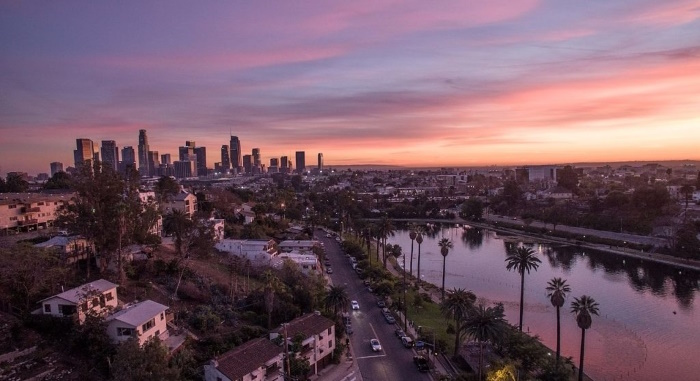About Los Angeles, California
 Los Angeles, Spanish for “The Angels;” officially the City of Los Angeles and often known by its initials L.A., is the cultural, financial, and commercial center of Southern California. With a population of almost 4 million, it is the second-most populous city in the United States (after New York City) and the most populous city in the state of California. Located in a large coastal basin surrounded on three sides by mountains reaching up to and over 10,000 feet Los Angeles covers an area of about 469 square miles. The city is also the seat of Los Angeles County, the most populated county in the country, with nearly 19 million residents.
Los Angeles, Spanish for “The Angels;” officially the City of Los Angeles and often known by its initials L.A., is the cultural, financial, and commercial center of Southern California. With a population of almost 4 million, it is the second-most populous city in the United States (after New York City) and the most populous city in the state of California. Located in a large coastal basin surrounded on three sides by mountains reaching up to and over 10,000 feet Los Angeles covers an area of about 469 square miles. The city is also the seat of Los Angeles County, the most populated county in the country, with nearly 19 million residents.
The heart of Southern California, LA became a world-class city very recently. At the start of the 20th century it was considered merely “a large village.” The city’s phenomenal growth was brought about by its equable climate, which attracted people and industry from all parts of the nation; the development of its citrus-fruit industry; the discovery of oil in the area during the early 1890s; the development of its man-made harbor—its port is one of the busiest in the United States—; extensive leisure, and outdoor recreation; and the growth of the motion picture industry in the early 20th century.
Los Angeles is a major hub of shipping, manufacturing, industry, and finance, and is world-renowned in the entertainment and communications fields. It is a favorite vacation destination and attracts millions of tourists to the area each year from all over the world. Apart from the movie studios and other landmarks associated with the movie industry, points of interest include the J. Paul Getty Museum, the Los Angeles County Museum of Art, the La Brea Tar Pits (famous for Ice Age fossils), Disneyland (Anaheim), and the Santa Anita and Hollywood racetracks. Additionally, LA has long been home to many major professional sports including, the NBA, NHL, NFL, and MBL with the Lakers, Clippers, Raiders, Rams, Kings, and Dodgers.
Los Angeles County is the nation’s largest manufacturing center, and the ports of Los Angeles and Long Beach are second only to New York as the largest customs district in the United States. Major employers in the Los Angeles Five-County area are in the business and management sector. Growth in the key wholesale industries—apparel and textiles, furniture, jewelry, and toys—and the boom in industrial trade have been a trend for the region. Other important sectors are health services and international trade and investment. After some lean years, the aerospace industry is making a modest comeback as a result of increased federal defense spending.
The City of Los Angeles holds many distinctions. L.A. is the entertainment capital of the world, a cultural mecca boasting more than 100 museums, and a paradise of idyllic weather. From tourist attractions like the Walk of Fame’s collection of stars (numbering more than 2,614 and growing by one or two a month) to career opportunities like those presented in the expanding tech industry, Los Angeles is the place to be. It is the only city in North America to have hosted the Summer Olympics twice. Downtown L.A. is the largest government center outside of Washington, D.C. Los Angeles has the only remaining wooden lighthouse in the state (located in San Pedro’s Fermin Park) and the largest historical theater district on the National Register of Historic Places (located Downtown on Broadway).
Services we offer in Los Angeles :
E Waste Recycling
Hard disk destruction
Destruction of Products
Kits for Recycling
See other cities in Los Angeles County
